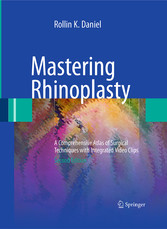Suchen und Finden
Mehr zum Inhalt

Mastering Rhinoplasty - A Comprehensive Atlas of Surgical Techniques with Integrated Video Clips
"8 Primary Rhinoplasty: Decision Making (p. 269-270)
Introduction
At this point in the text, the surgeon should understand and feel comfortable with each step in the basic rhinoplasty operation. The challenge now is how to progress from Level 1 cases to more complicated deformities, which require a broader array of surgical techniques. What is a logical progression? Surprisingly, many Level 2 nasal deformities are simply Level 1 cases, but with one component being markedly more difficult.
For example, many patients with underprojecting tips require a standard approach to the rest of the nose, but sophisticated use of columellar struts and add-on grafts for the tip. Fortunately, the surgeon can progress to Level 2 cases using the basic skills mastered in Level 1 cases. This chapter will emphasize tip surgery because the reality of private practice is that “as the tip goes so goes the rhinoplasty” for both patient and surgeon. In addition, the surgeon will learn how to recognize Level 3 cases. Ultimately, each surgeon will develop their own grading system for Level 1–3 cases, which will facilitate selection of cases and techniques resulting in an expansion of their comfort zone.
Tip definition
Tip Definition is defined with difficulty, but it is essentially the visibility or distinctive set-off of the dome defining point from the rest of the alar cartilage (Fig. 8.1). Its anatomical correlate is more easily specified – the domal junction line between domal segment and lateral crura. A convex domal segment juxtaposed to a concave lateral crura produces the most attractive tip and is the configuration I try to achieve with the domal creation suture.
Decision Making. Tip definition is carefully assessed from all four views and the patient is asked for their opinion. Tip projection and skin thickness are critical correlates. Thick skin precludes subtle corrections, while thin skin makes any abnormality more visible. An example of the latter is the patient with thin skin who does not like a visible bifidity in the infralobule (a problem easily corrected with a concealer graft of excised alar cartilage). In contrast, too little tip definition is a common complaint for most rhinoplasty patients and will be discussed in depth.
Level 1. In minor deficiencies, the tip is “all right,” but lacks the distinctiveness to set it off from the tip lobule on oblique view and the dorsal line on profile view. One can easily correct these deficiencies with a tip suture technique. First, a columellar strut is inserted to insure adequate support. The domal segment is pinched at the domal notch to determine where to place the domal creation suture. These sutures are inserted bilaterally followed by an interdomal suture.
The skin is redraped and a tip position suture is added if necessary. Level 2. When tip suturing is insufficient, then the desired domal definition can be created using add-on grafts (TRG) of excised alar cartilage. This is either shield shaped to fill the infralobule thereby creating a tip line, or domal shaped to set-off the tip from the dorsal line. These infralobular grafts are designed to fit within the sutured alars while rising above the domal notches. The domal graft is made both short (8 mm) and narrow (4 mm), and then sutured to the domes. It can be either a single or double layer. One is accentuating the domal segments above the adjacent lateral crura."
Alle Preise verstehen sich inklusive der gesetzlichen MwSt.











